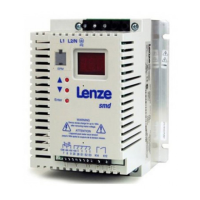How to troubleshoot Remote keypad fault on Lenze Inverter?
- DDaniel McintyreSep 12, 2025
If the Lenze Inverter shows 'Remote keypad fault', it means the remote keypad is disconnected. To resolve this, check the remote keypad connections.
How to troubleshoot Remote keypad fault on Lenze Inverter?
If the Lenze Inverter shows 'Remote keypad fault', it means the remote keypad is disconnected. To resolve this, check the remote keypad connections.
Why Lenze DC Drives show earth fault?
An earth fault in Lenze DC Drives can occur if a motor phase is grounded, so you should check the motor and motor cable. It can also be due to excessive capacitive charging current of the motor cable, in this case use shorter motor cables with lower charging current.
What to do if Lenze DC Drives have controller overtemperature?
If the controller has an overtemperature, it means the controller is too hot inside. To resolve this, reduce the controller load and improve cooling.
What causes automatic start to be inhibited in Lenze DC Drives?
If automatic start is inhibited in Lenze DC Drives, it is because c42 = 0. You should apply a LOW-HIGH signal change at terminal 28.
What does DC-injection brake active mean on Lenze ESMD153L4TXA Inverter?
If the Lenze Inverter is showing 'DC-injection brake active', it means the DC-injection brake has been activated either via digital input or automatically. To deactivate it, ensure the digital input is LOW or wait for the holding time c06 to expire if it was activated automatically.
What to do if Lenze DC Drives show data on EPM not valid?
If Lenze DC Drives indicate that the data on the EPM is not valid, it means the data is not valid for the controller. Use an EPM providing valid data or load the Lenze setting.
What to do for Controller overtemperature on Lenze Inverter?
If the Lenze Inverter displays 'Controller overtemperature', it means the controller is too hot inside. To resolve this, reduce the controller load and improve cooling.
What does current limit reached mean on Lenze ESMD153L4TXA?
If the Lenze Inverter shows 'Current limit reached', it indicates a controllable overload. This is managed automatically, as described in C22.
What to do if Lenze DC Drives show EPM error?
If Lenze DC Drives display an EPM error, the EPM might be missing or defective. Power down the system and replace the EPM.
What causes motor overload on Lenze Inverter?
If the Lenze Inverter displays a motor overload (I2t overload), it means the motor is thermally overloaded. This can be due to: * Impermissible continuous current. * Frequent or excessively long acceleration processes. To resolve this: * Check the controller selection. * Check the setting of c20.
General safety precautions for Lenze controllers, covering risks from live parts and hot surfaces.
Guidelines for using drive controllers in machines and compliance with EC directives like Machinery Directive.
Proper handling, avoiding mechanical stress, and preventing damage to electronic components during installation.
Observing national regulations and appropriate procedures for electrical installation, including cable and PE connection.
Ensuring systems have monitoring/protection devices and following operational safety rules like closing covers.
Policy on using inverter products with explosion proof motors, including liability and risk assumption.
Explanation of pictographs (Danger, Warning, Stop, Note) and their consequences if ignored.
Conformity, approvals, environmental conditions, and operating parameters for the inverter.
Electrical ratings including input voltage, current, and output current for various inverter models.
Guidelines for physical mounting, dimensions, and environmental considerations for the inverter.
Procedures for wiring, EMC requirements, fuses, cable cross-sections, and connection diagrams.
How to navigate the controller interface to set and change parameters.
Information about the EPM for storing, transferring, and managing parameter settings.
Detailed description of parameter codes, possible settings, and important notes for configuration.











